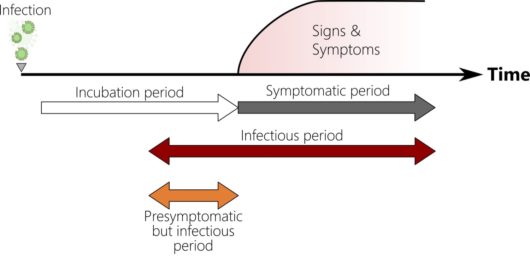When does a COVID-19 infected person become a danger to others? This question has profound implications, both for prevention of the disease and for the lifestyles of everyone involved. And, the logic of the answers is relevant to a large number of other infectious diseases, like influenza, measles, chickenpox, and the common cold.
Let’s follow the above timeline. The incubation period is from the moment a person is exposed to the infection until the person develops signs and symptoms of disease. But many diseases, including COVID-15 and measles, become infectious to others before the person develops signs and symptoms (such as cough, fever and skin rash). The pre-symptomatic but infectious period is especially hazardous, since the person is unknowingly exposing others to the disease. It is for this reason that people who know they are exposed to COVID-19 are quarantining themselves. Failure to do so would put people in their circle at risk.
One especially troublesome complication surrounds people who are never-symptomatic but infectious. They are spreading the infection but never becoming sick themselves. Therefore, these persons would never know that they must quarantining themselves. This is one of the strongest rationales for virtually everyone to wear face masks.
Finally, when is the end of the infectious period? For many diseases, as the signs and symptoms diminish, so does the risk of infecting others. But in the case of COVID-19 the answer is not entirely clear. Some persons who have entirely recovered may still be infectious towards others, and this continues to be the subject of active research.
So, when does a COVID-19 infected person become a danger to others? While we can extrapolate lessons from other infectious diseases, the exact facts surrounding this particular disease are still being established. In the meantime, we all do well to continue exercising caution to protect ourselves and our communities.

